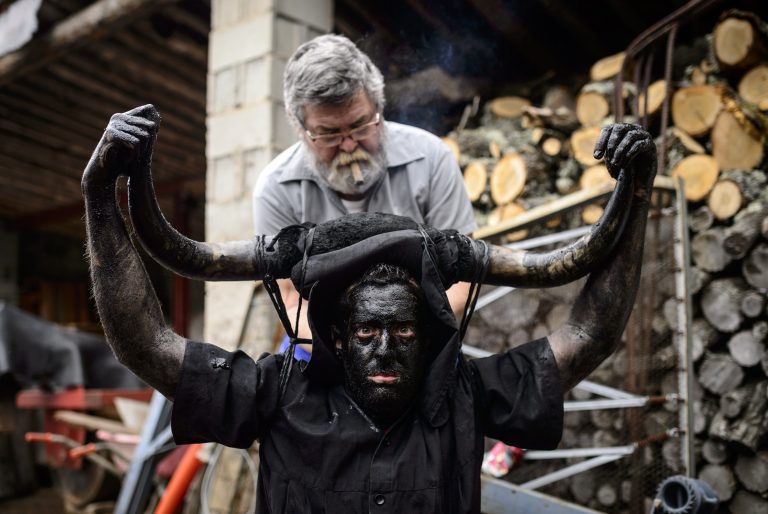
Image by Dani Pozo/Getty Images, © All Rights Reserved.
The Devils of Luzón
Welcome to Luzón, Spain, and its annual Fiesta de los Diablos y Macaritas — the Festival of Devils and Masked Figures. The ancient carnival takes place in mid-February each year, and turns out hundreds of people, young and old. They march and dance through the streets while ringing bells, clad in inky or colorful robes, faces covered with ghostlike masks or blackened with grease and soot.
While many of the world’s cities find themselves bedecked in the pink and red hearts and cherubs of Valentine’s Day, in this small town in northern Spain, the narrow winding streets come alive with a playful battle between specters of good and evil.
Two characters make an appearance on this day: los diablos and las mascaritas.
Los diablos are innocent villagers possessed by evil spirits that emerge once a year, according to folklore, from a mysterious, hidden crack in the earth. Their greatest pleasure is to “curse” oblivious humans by smearing them with the same black that marks them.
Las mascaritas are their ghostlike counterparts: white-masked figures in traditional women’s clothing, immune to the devils’ pranks.
Preparations for the festival begin at midday when the performers playing the devils hide away in a secret location to transform themselves into the frightening aspect of los diablos.

Participants enrobe in pitch-black cloaks and slather their skin in protective creams…

…before painting their faces and arms black with oil and soot.

Bull’s horns are secured to their heads and shoulders with tape and twine. Around their waists hang strings of huge cow bells — called cañones, or “cannons,” for their shape and their roaring sound that fills the town.

The diablos bite into chunks of raw potato carved to look like huge, fearsome teeth. Against the inky black of the devils’ clothing and skin, the startling white of the teeth and eyes emphasizes the diablos’ surreal, unsettling appearance.

Pre-Christian Celtic traditions like La Fiesta de los Diablos dot the Iberian Peninsula. In wintertime, they fixate on a distinct theme of survival, with traditions focused on expelling dangerous spirits that might jeopardize the health of the community and the land in a time of scarcity.

The festival fell out of practice for decades under Francisco Franco’s regime. But thanks to a group of locals hoping to revive and preserve the lost traditions of the region, working with the memories of the village’s elders, the festival was brought back to the streets of Luzón in the 1980s — with a few modern updates to open the celebration to all of the village’s residents and visitors. Where previously only men participated in the performances, women and children are now welcome to don diablo or mascarita costumes, as well.

In today’s celebrations, costumes and disguises of any kind — not just the traditional dress of the mascaritas — can thwart the attention of the diablos.

Revelers turn out in fun and frightening fancy dress of all sorts, from cartoon characters, nuns, and priests to pirates and grim reapers, to hide their humanity from the devils who seek to smite them.

Now, those most vulnerable to the diablos’ harassments are tourists who arrive unprepared and undisguised. As the local warning goes on the day of the fiesta, “Anyone who is not disguised shall be smitten!”

The diablos and mascaritas emerge in the early afternoon. The later hours of the day are the devils’ province; they’re attracted to the dimming light of the winter afternoon, which amplifies their ominous aspect.

Throughout the afternoon, the devils, mascaritas, and civilians march and dance through the town’s streets, making their way to the town square in the center of Luzón. All the while, a thrilling game of tag ensues, with the diablos startling the undisguised with a staining grab.

In the early evening, the revelers finally gather in the town center. The square serves as a monument to the devils — a portal back to the underworld. Before they leave the realm of the living, the diablos perform a spirited dance to traditional Spanish music, flaunting their horns and clanging their bells — the sound finally driving the evil spirits from the bodies of the possessed.

At last, at dusk, la fiesta has come to an end. The evil spirits have been exorcised from their victims’ bodies, and from beneath the fading face paint, friendly and familiar human faces emerge once again.

La Fiesta de los Diablos might be unsettling to the unfamiliar, but it is a joyous celebration, a hidden gem in the calendar of Iberian and Latin American carnival celebrations. Not unlike Mexico’s Dia de los Muertos or Halloween (also speculated to have roots in Celtic tradition), the festival is a time of playful revelry; a vestige of a rich and little-known history of northern Spain.
Share your reflection